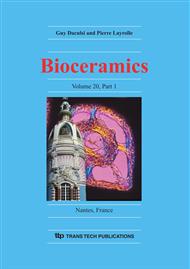p.767
p.771
p.775
p.779
p.783
p.787
p.791
p.795
p.799
Environmental Phase Stability of Ceramics Composite for Hip Prostheses in Presence of Surface Damage
Abstract:
Alumina matrix composite (AMC) has been widely used for artificial hip and knee joints because of its phase stability in human body and its excellent wear resistance. The excellent mechanical properties of strength and fracture toughness of zirconia materials are well known to be closely related to stress-induced transformation from the tetragonal to the monoclinic phase, which is accompanied with 4% volume increase of the zirconia crystal cell. However, it is also to be considered that the material is prone to low temperature aging degradation (LTAD) under hydrothermal environment, like in the human body. This LTAD is influenced by the tetragonal to the monoclinic (t-m) phase transformation. T-m transformation also induces the formation of microcracks at the material surface, and an increase in surface. Microcracking leads to a decrease of mechanical properties, and could explain the failure of implants after some years in vivo [1, 2] .Therefore, it is very important to study how to prevent phase transformation in zirconia components. Transformed monoclinic zirconia percentage can be experimentally measured by Raman spectroscopy and the residual stress distribution, which is related to phase transformation, can be determined by a non-destructive piezo-spectroscopic analysis. In this paper, we attempted to evaluate it from both stress and mechanical properties points of view by confocal Raman and fluorescence spectroscopy.
Info:
Periodical:
Pages:
783-786
Citation:
Online since:
November 2007
Authors:
Keywords:
Price:
Сopyright:
© 2008 Trans Tech Publications Ltd. All Rights Reserved
Share:
Citation:


